new posts in all blogs
Viewing: Blog Posts Tagged with: monarchs, Most Recent at Top [Help]
Results 1 - 9 of 9
How to use this Page
You are viewing the most recent posts tagged with the words: monarchs in the JacketFlap blog reader. What is a tag? Think of a tag as a keyword or category label. Tags can both help you find posts on JacketFlap.com as well as provide an easy way for you to "remember" and classify posts for later recall. Try adding a tag yourself by clicking "Add a tag" below a post's header. Scroll down through the list of Recent Posts in the left column and click on a post title that sounds interesting. You can view all posts from a specific blog by clicking the Blog name in the right column, or you can click a 'More Posts from this Blog' link in any individual post.
So far this summer, we’ve stuck close to home. We’re working on projects around the house and the yard, and some days, everything feels like a science experiment. Lucky for us, we’re still learning!
I’m tending monarchs in the backyard—this is my sixth year—and finding them fascinating as usual. I learn something new every year. This year, I’m taking a more hands-off approach. I trust that they know what they’re doing. (You can see more photos, monarch info, and the tent where I keep them on
my web site.)
I started milkweed plants from seed again this spring. A couple of last year’s butterfly milkweed plants are blooming, but this year’s are still tiny. I was surprised to see when I repotted a few that the roots were filling the pots. Lesson learned: Larger pots to come.
We’re experimenting with food, too. My husband discovered a mulberry tree, so we’ve been picking, baking, and eating them fresh by the handful. And in our granola, of course, the latest batch of which includes the maple syrup we bottled last winter. So satisfying!
This year’s garden includes way too much kale, which we’ve added to salads, given to neighbors, and last night baked in a quiche with oven-roasted tomatoes and cheddar cheese. Possibly the best quiche ever—so glad I made two!
My summer reading includes a large pile of botany books for a new nonfiction picture book I’m excited to work on. My writing group gave me positive reviews, encouragement, and a number of helpful suggestions I can’t wait to try. Must get back to it! But first, here’s a mulberry poem:
Squirrel stares at me—
mulberry stained, pail half full.
We can share, can’t we?
Kimberley Moran is hosting today’s
Poetry Friday Roundup. Enjoy! And happy summer!
JoAnn Early Macken

I was inspired by one of my own characters to plant a “bee garden,” this spring, and today planted the better part of my wife’s little pocket of prairie with beardtongue, salvia, bee balm, black-eyed susans, coneflowers, thymus, verbena, coreopsis, asclepias, and yarrow. There’s an empty spot for milkweed we’re getting from a neighbor. The stuff in back is prairie grass that’s (mostly) been there for years.
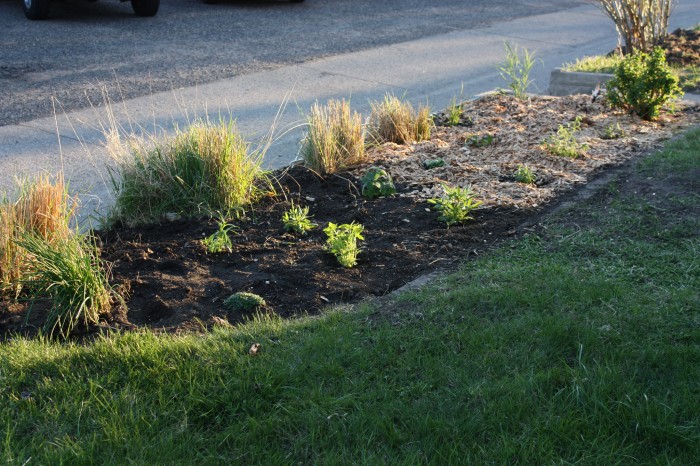
It doesn’t look like much now, but by mid-summer most of these guys will be 2-4 feet high, in bloom, humming with bees and crawling with caterpillars. My wife even supports this venture though she doesn’t like butterflies, but it will be hard not to be taken in by the potential magic of watching, with our bug-loving boy, a monarch nudging its way out of a chrysalis one late summer morning. Thanks to a book by a local author, he is also expecting bison.
Filed under:
Miscellaneous Tagged:
bees,
gardening,
monarchs,
native grasses and forbs,
phyllis root,
plant a pocket of prairie,
pollinators 


In a recent blog post, Marion Dane Bauer addressed a topic important to all writers who hope to have their work accepted for publication. “When I begin a new manuscript,” she says, “especially one that will require a major commitment of time, I pause to consider whether what I want to write will be marketable.” In the series of posts that starts today, we Teaching Authors discuss our own experiences with and thoughts about the question of marketability.
For five summers now, I’ve been gathering monarch butterfly eggs and caterpillars and raising them in our backyard, protected from predators by a mosquito net tent. Last winter, I finally—finally!—found a way to write about the process in a series of haiku. Sidebars include facts about monarchs and tips for readers who might want to raise them, too. I call the poems “butterflyku” and the collection
Butterflyku and Monarch How-To.
Here’s an excerpt:
Searching milkweed leaves,
I find what I’m looking for:
tiny monarch egg!
Five rejections later, I’m facing the prospect that this subject, important as it is to me, might not be acceptable in this form. Although I know that many manuscripts are sold after more than five rejections, I also understand that poetry collections are notoriously tough to sell. So I’m taking a different approach, a narrative nonfiction one that I hope will be more appealing to both editors and readers.
As I organize my thoughts in this new direction, I’m still learning. I attended a symposium last week at the Chicago Botanic Garden with brilliant speakers who elaborated on the urgent issues affecting monarchs today. I soaked up every word, took pages and pages of notes, and collected handouts to study.
To prepare for this year’s monarch project, I started three varieties of milkweed from seeds we collected last fall.
 |
| top to bottom: common, whorled, and butterfly milkweed |
Now the monarchs are back! Eggs are hatching! Caterpillars are growing! Today's tally includes 4 eggs and 7 caterpillars. I’m heading back outside to keep an eye on the amazing creatures and their awe-inspiring transformation so I can try, try again with a topic that’s not only important but also fascinating and dear to my heart.
Wish me luck!
Don’t forget to
enter our current giveaway for a chance to win an autographed copy of Joan Bransfield Graham's new book,
The Poem That Will Not End: Fun with Poetic Forms and Voices!
JoAnn Early Macken


By: sylvandellpublishing,
on 9/11/2013
Blog:
Sylvan Dell Publishing's Blog
(
Login to Add to MyJacketFlap)
JacketFlap tags:
Children's Books,
science,
chrysalis,
butterflies,
Educational,
Book Launches,
caterpillars,
monarchs,
monarch migration,
butterfly facts,
Add a tag
 Officially launched to yesterday, A Butterfly Called Hope by Mary Alice Monroe with butterfly expert Linda Love and photography by Barbara Bergwerf is sure to inspire young entomologists out there.
Officially launched to yesterday, A Butterfly Called Hope by Mary Alice Monroe with butterfly expert Linda Love and photography by Barbara Bergwerf is sure to inspire young entomologists out there.
Kick off the school year with this fun book about a young girl and her experience with the amazing journey of a Monarch Butterfly! This book not only shows the entire metamorphosis of a caterpillar becoming a butterfly, but it also provides interesting facts for readers to learn more about these flying beauties. This is the fourteenth book by New York Times best-selling author Mary Alice Monroe, and features incredible photographs by Barbara Bergwerf that document Hope’s entire journey in raising a butterfly.

Curious for more? Here are some fun and interesting facts about Monarch Butterflies:
-Did you know that Monarchs go through four generations each year?
-Did you know that Monarchs are the only insects that can migrate up to 2,500 miles?
-Did you know that Monarchs are actually poisonous as a defense against predators, but are harmless to humans?
-Did you know that male Monarchs have black spots on their wings, and the females don’t?
-Did you know that Monarchs migrate during the winter to warmer climates like Mexico and Southern California?
-Did you know that the first 3 generations of Monarchs only live up to 8 weeks, but the fourth generation can live up to almost a year?
-Did you know that climate change is a threat to Monarchs? Wetter climates during the winter can cause Monarchs to freeze to death because they can only survive in dry winter climates.
Do you want to learn more fun facts about butterflies visit the webpage and download the free For Creative Minds section and Teaching Activities where you can even learn how to raise your own monarch butterfly! http://www.sylvandellpublishing.com/bookpage.php?id=ButterflyHope
Send us your favorite butterfly fact and you will be entered to win a copy of A Butterfly Called Hope!


A few months back, my summer-to-come looked about the same as the previous ones: teaching two six-week classes with a semester break before and after. Then my classes were canceled.
Surprise!
In addition to having all the time I wanted to write, work in the garden, and jettison some of the detritus in my workspace, I envisioned a glorious three months of camping, canoeing, and riding around on the tandem with my husband, who has his summers off from teaching.
Then he crashed his bicycle, breaking three ribs and his right hip socket. After spending a week in the hospital and undergoing surgery to repair his hip, he's home now, recovering nicely but hampered a bit by the crutches he'll need for three months.
My plans? Revised again. How? Here's what I told myself:
1. Count your blessings.
2. Take stock. Look closely at that To Do list. Decide what’s doable and what’s not really so important, and prioritize the important stuff.
3. Define minimum requirements. Simplify. Lower your standards. Recognize your limits. In other words, do what you can. Work around the edges if you can’t plunge in. I had planned an ambitious monarch butterfly study project that just isn’t going to happen this year. Instead, I hung a mosquito net from the side of the garage, and I’m protecting a few, watching them grow, taking pictures when I can, and hoping to figure out what I want to write about them.

4. Let everything else go. In the long run, a whole lot of effort turns out to be busy work. The garden is thriving without much attention from me. I wish I had taken pictures of the anemones waving in the wind on the top of our front hill. And the peonies! O, the peonies! Now we have day lilies, monarda, and daisies. From across the street, you can’t tell that yellow coneflowers are taking over, crowding out the smaller plants beneath them. I bet they’ll be pretty, too.
5. Take care of yourself. Don’t skip the walk to do the dishes. Write a snippet in a waiting room. And as April says, remember to breathe.
JoAnn Early Macken
How many times have you read The Very Hungry Caterpillar aloud?
It’s got to be in the hundreds for me. Seems like every single one of my kids has had a time when that book was the favorite above all others.
But in all these years, I’ve never actually seen a real caterpillar egg—until now.

Can you see it? The little white dot on the underside of the leaf, quite near the stem. I watched the butterfly lay this egg and immediately afterward I ran inside for the camera, so this photo was taken no more than two minutes into the egg’s existence.
I hope the other caterpillars don’t eat that leaf. They are munching away and growing quite fat. We’ve counted up to eleven at one time but it’s likely we’re missing a good many. Counting callerpidders has become Rilla’s favorite thing to do. Mine too!

Butterfly watch: two monarchs, a tiger swallowtail, several painted ladies, and assorted sulphurs and cabbage whites. Also a possible viceroy sighting but Jane, my resident expert, wasn’t there to confirm.
As for our blue flower…Jenn, I was sure it was a cornflower too, but the rest of them are coming up—

pink!
(The color’s a bit washed out in this photo. The flower is really a soft shade of pale pink. Hmm….)
There’s a monarch on our milkweed.
There’s a monarch on our milkweed!
You know how happy that makes me, right?
Here she is (not on the milkweed):
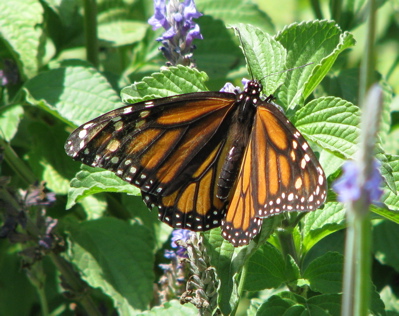
Welcome, little dear. Invite your friends!
















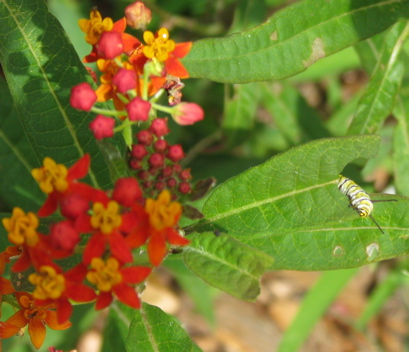
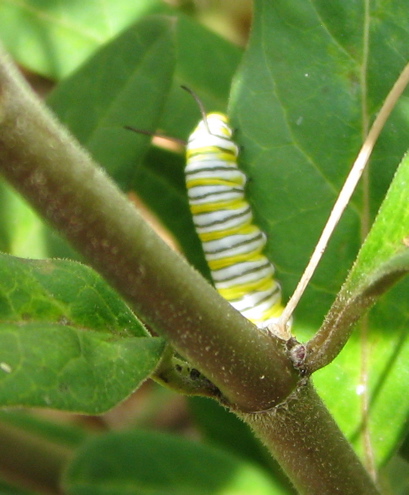




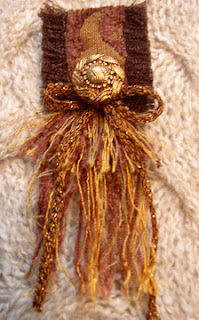
Love them, Paula! You seem to have the same need to mess around with fabric that I do.
I have been feeling a serious bout of sewing coming on for a while now.